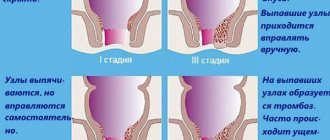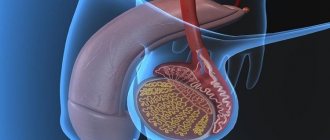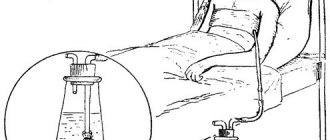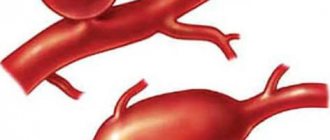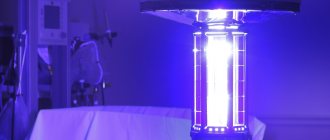Causes of varicocele
Varicocele is a disease that occurs in men and results in dilation of varicose veins in the testicles. This pathology affects the full functioning of blood vessels and increases pressure in the veins. Varicocele is more common on the left testicle, rarely on both.
IMPORTANT! Information from the article cannot be used for self-diagnosis and self-medication! Only a doctor can prescribe the necessary examinations, establish a diagnosis and draw up a treatment plan during a consultation!
The main reasons causing dilation of the veins of the testicles include:
- genetic predisposition to varicose veins;
- physical activity with constant lifting of weights;
- features of the anatomical structure that contribute to pinched veins in the genital organs;
- neoplasms (both benign and malignant);
- constipation and diarrhea in the chronic stage;
- irregular sex life;
- increased body weight;
- various inflammatory processes.
Causes of development and risk factors
Expansion of the pampiniform venous plexus of the testicle - varicocele often develops on the left, since the left testicular vein, unlike the right, flows into the vein of the left kidney. Due to anatomical features (compression between the aorta and mesenteric artery), blood pressure in the left renal vein system may increase. The blood begins to put pressure on the valves of the testicular vein and lead to the reverse flow of blood through it. Violation of venous hemodynamics leads to stagnation in the pampiniform plexus of the left testicle with the development of varicose veins of the spermatic cord and the development of testicular varicocele. In 10% of cases, there is a high anomalous drainage of the right testicular vein into the right renal vein, which can cause a varicocele on the right.
A significant increase in pressure in the renal vein causes incompetence of the testicular vein valves and the development of a bypass with reverse flow of renal venous blood through the testicular vein into the pampiniform plexus. A congenital valvular defect of the testicular vein is also possible. In the standing position of the patient, the blood flow in the testicular vein is distorted and directed centrifugally from the renal vein down into the pampiniform plexus (orthostatic varicocele). In the horizontal position of the patient, the direction of the venous flow is restored and becomes normal - from the testicular vein to the renal vein. Dilatation of the veins of the spermatic cord and scrotal organs is usually detected during puberty and tends to steadily progress.
One of the types of hypertension in the vessels of the spermatic cord is the formation of an arteriovenous fistula in the renal vascular bed, as happens with a kidney tumor or post-traumatic arteriovenous fistula. Extreme varicocele, as a complication of the disease, can develop within a very short time. The development of the disease is based on the development of venous hypertension in the kidney and reverse blood flow to the testicles.
Treatment of varicocele and effect on male infertility
Treatment of varicocele is carried out exclusively by surgery, since only surgery can give the best effect. Read more.
There are different types of operations. It is believed that at present the microsurgical method of surgical treatment is the most effective: it allows surgical intervention to be performed with the least tissue damage as a result, rehabilitation time takes less time.
The operation helps restore blood flow in the testicles and restore normal spermatogenesis (production of a sufficient number of living and anatomically correct sperm). Improving the quality of sperm and eliminating pain will allow you to have a full sex life, without the threat of infertility. From childhood, varicocele prevention should be done, since hereditary acquisition of the disease is possible. It is important to see a urologist regularly.
Dr. Tkachenko Grigory Gennadievich – urologist-andrologist, surgeon, doctor of the highest category. Conducts both conservative and surgical treatment of urological patients, as well as diagnosis of diseases of the MVS organs. Find out more about the doctor.
Symptoms
The initial form is asymptomatic and is discovered mainly by chance during examination by a urologist.
The second stage begins to manifest itself with minor pain that goes away in a lying position, discomfort and an increase in the size of the scrotum. Increased sweating and a burning sensation in the scrotum area are increasingly observed, and problems arise during sexual intercourse.
With varicocele of the third stage, the pain is constant and does not depend on the position of the body and the physical activity performed. Significant asymmetry upon visual inspection, swollen dilated veins form a blue cluster. Poor circulation and increased temperature inside the testicle lead to changes in the structure of sperm and their motility. This leads to infertility.
Only surgical intervention is indicated, especially if the man is of childbearing age. If the disease is advanced, the processes may become irreversible, the veins can be removed, but reproductive function cannot always be restored. Only a timely visit to a urologist in St. Petersburg gives effective results.
Ointments
For varicocele, ointments prepared according to folk recipes are effective. They are based on herbs with anti-inflammatory, capillary-protective effects.
St. John's wort
To prevent blood stagnation in the testicles, an ointment with St. John's wort is used:
- 4 cups of fresh herbs are passed through a meat grinder;
- juice is squeezed through gauze;
- boil in a water bath for 15 minutes;
- mix with 200 ml of melted butter;
- Place the mixed mass in the refrigerator for half an hour.
When treating varicose veins of the scrotum, the ointment is used 4-5 times a day. The therapeutic course takes 6 weeks.
Sagebrush
Folk recipes with wormwood herb are effective in combating the expansion of superficial blood vessels. To get rid of the symptoms of varicocele, use the following ointment:
- dry the grass in the sun;
- grind to powder;
- mix with vegetable oil in a ratio of 1:4;
- leave in a glass container for 2 days.
Apply ointment to the affected area 4-6 times a day. The course of treatment ranges from 2 to 8 weeks.
Sitz baths
As part of the traditional treatment of varicose veins of the pelvic veins, belt or sitz baths are used. They stimulate blood circulation in the testicles and prevent blood clots.
Angelica
The medicinal angelica (angelica) has antispasmodic, anti-inflammatory and venotonic activity. To treat varicocele, a herbal decoction is used:
- 200 g of raw materials are boiled in 2 liters of water for 5 minutes;
- the filtered broth is poured into the bath;
- mix with warm water (45-50°C);
- The bath is taken daily for 25-30 minutes for 2 weeks.
Before using traditional methods of treatment, consult your doctor. Baths are contraindicated for bacterial proctitis and hemorrhoids.
Willow
In folk therapy, baths with white willow bark are considered especially useful:
- 5 tbsp. l. boil the crushed bark in 3 liters of water for 10 minutes;
- the cooled broth is mixed with warm water;
- The bath is taken for 15-20 minutes once a day.
The duration of treatment depends on the severity of varicocele symptoms. In 2/3 of patients, the heaviness in the scrotum goes away after 4-5 procedures.
Calendula
Calendula leaves and flowers have vascular strengthening, anti-inflammatory and antiseptic properties. They are used to treat varicocele for any degree of varicose veins.
Traditional recipe with calendula:
- a glass of leaves and flowers of the plant is soaked in 1 bucket of hot water for half an hour;
- the strained infusion is heated to 50°C;
- poured into the bath.
The course of treatment is 2-4 weeks. Belt baths are taken for 15-20 minutes once a day.
Treatment
Before starting to treat varicocele, the doctor will conduct a diagnosis using one of the methods indicated in the previous section. A method is selected based on the results of research and analysis.
- Ivanissevich's operation.
This is a surgical method. It involves crossing an enlarged vein (or several). The intervention is carried out under general anesthesia.
The surgeon makes an incision in the iliac region parallel to the inguinal canal, dissecting the skin, subcutaneous tissue and connective tissue membrane of the inguinal canal. Afterwards its wall is dissected. Dilated veins are located inside. After the operation, all tissues are sutured in layers.
- Laparoscopy.
It resembles Ivanissevich’s operation, but all manipulations are carried out through punctures in the abdomen. A special feature is the need to stretch the abdominal cavity with the help of carbon dioxide. Plus - there is no need for multiple cuts and incisions.
Laparoscopy has many disadvantages, due to which the method is almost never used. This:
- the likelihood of injury to nearby organs;
- high risk of developing dropsy after this operation for testicular varicocele;
- the risk of recurrence of the disease is almost 20%.
- Microsurgery Marmara.
The least invasive method. In the case of Ivanissevich's operation, the incision is 5 centimeters, in the case of microsurgery - only 2 centimeters. Thus, understandably, less tissue is injured.
The recovery period is short, the likelihood of complications is much lower compared to other surgical methods. The advantage of treating varicocele using microsurgery is the ability to eliminate pathological discharge of venous blood after surgery. The probability of relapse is up to 2.5%.
An incision is made by the surgeon in the groin area, and the spermatic cord is removed. After opening the membranes, all dilated veins are separated from each other and stopped. The operation is performed under a microscope or using other magnifying equipment. After this, absorbable sutures are placed on the tissue.
Diagnostics
Modern equipment makes it possible to detect the disease even at the zero stage, when nothing is felt externally or upon palpation. Ultrasound of the scrotum and Dopplerography of blood vessels are necessary when the veins are not visually dilated and it is difficult to make a diagnosis using palpation. At the second and third stages of the disease, the doctor can make a diagnosis based on an external examination; additional examination is prescribed as necessary.
In any case, it is necessary to conduct a study of sperm quality. The spermogram is done twice, with a break of several days; before taking it, you must abstain from sexual intercourse for two to seven days.
In what cases should you consult a doctor?
Seeking help from a doctor during the healing process of a suture is a completely normal practice, even in the absence of serious problems. And in the event of adverse reactions due to a violation of the treatment regimen or any unforeseen circumstances, it is absolutely impossible to delay it. First of all, it is dangerous to ignore the following symptoms:
- bleeding that cannot be stopped by conventional means;
- high temperature (more than 38 degrees);
- weakness, chills;
- increasing pain or other progressive discomfort that cannot be relieved with medications;
- purulent discharge of a bright yellow or green color with a thick consistency and very often with an unpleasant odor;
- severe redness, swelling, or swelling in the wound area;
- the skin at the site of injury is hard and hot to the touch;
- the appearance of a rash or blisters;
- Suspicion of seam dehiscence.
How long does it take for a wound to heal after surgery?
The rate of healing of a postoperative wound depends on many conditions. Among them:
- age;
- body mass;
- state of immunity;
- state of the cardiovascular system.
On average, it takes about 3 months from the moment of surgery to the formation of a scar. Depending on the complexity of the operation and if there are complications, this period may last 12 months. Tissue regeneration takes place in 4 stages.
- Inflammation (5–7 days). The body's standard defense reaction to damage. During this period, there is an increased production of substances that stimulate blood clotting.
- Polyferation (from 10 days to 1 month). At this stage, the formation of young connective (granulation) tissue, penetrated by a dense network of microvessels, occurs. At first it is bright red in color and grainy in consistency, but as the wound heals it becomes pale and smooth, and its bleeding decreases.
- Epithelization (from 1 to 3 months). The connective tissue is finally formed. Skin begins to form at the site of the wound. The number of vessels decreases, a scar forms.
- Scar formation (from 3 to 12 months). Temporary vessels completely disappear. Fibers of collagen and elastin - elements of connective tissue - form the scar.
Juices
Freshly squeezed juice from plants and fruits is a source of anticoagulants, vitamins and microelements. This folk remedy stimulates cellular metabolism and strengthens the walls of blood vessels in case of varicocele.
Kalina
The berry normalizes venous pressure, thereby reducing the load on the vessels feeding the testicles. When fighting varicocele, juice with viburnum is taken in courses of 2 weeks.
Folk recipe from viburnum for varicocele:
- 200 g of viburnum fruits are passed through a meat grinder;
- mix with 15 ml of melted honey;
- 150 ml of juice is diluted with 100 ml of mineral water without gas.
For the treatment of varicocele in men, take 250 ml of diluted juice 3 times a day 1 hour after meals.
Rowan
Rowan fruits contain vitamins, organic acids and microelements that strengthen the walls of veins, speed up metabolism and relieve inflammation. As part of traditional therapy for varicocele, the following remedy is used:
- 150 g of berries are passed through a meat grinder;
- 50 ml of juice is diluted with the same amount of mineral water;
- add 20 ml of sweet clover honey.
During the course of treatment for varicose veins of the small pelvis, drink 100 ml of solution 2-3 times a day for 14 days.
Lemon
Lemon juice has a powerful venotonic, tonic and antiseptic effect. For varicocele it is used in diluted form:
- 30 ml of lemon juice is mixed with 50 ml of sweet apple juice;
- diluted with 80 ml of still mineral water;
- add 1-2 tsp. honey
The prepared solution is drunk on an empty stomach in the morning and evening. The course of treatment is 10 days.
The appropriateness of wait-and-see tactics
An obligatory companion to varicocele is a stagnant process in the vessels.
For this reason, some patients begin to take herbal infusions that thin the blood and relieve blockages in the veins. But since the pathogenetic mechanism of the disease does not consist of stagnation, taking tinctures can only relieve pain symptoms, and not eliminate the enlarged segment on the testicular vein or stop the retrograde outflow of blood. Such techniques as massage, yoga, and taking venotonic medications are also of questionable effectiveness. These measures are aimed at eliminating congestion in the veins of the testicle, but have no effect on reflux. The longer a man self-medicates, the more time he loses without undergoing surgery and causing damage to his health.
You can follow the wait-and-see approach only as directed by your doctor. The reasons for monitoring the progress of the disease and postponing surgical intervention indefinitely can be different, ranging from the absence of pain and normal spermogram parameters to the compliance of testicular trophism with the norm. Another reason for delaying the operation can be identified: waiting for the deadline for the quota for free treatment.
In our Clinic, varicoceles have quotas for free elimination by performing subinguinal microsurgical varicocelectomy according to Marmar. If there is a need to postpone the operation for some time, then our specialists will monitor the progress of the disease and the doctor will necessarily prescribe a cream developed in our clinic. It can also be obtained by using a quota.
Prices for services
Initial appointment with a urologist FOR MEN + ultrasound of the prostate gland (assessment of complaints, medical history, if necessary, rectal digital examination, ultrasound of the prostate gland in men)
Primary appointment – visiting a doctor of a specific specialty for the first time. Includes a conversation with the patient, an initial examination, anamnesis, if necessary, a digital rectal examination, and an ultrasound of the prostate gland. The price is valid from 02/01/2021 The price is not valid for appointments at the branches of Bolshevikov Ave. and Prosveshcheniya Ave. Make an appointment
550 ₽
Initial appointment with manager Department of Urology Rylchikov I.V. + Ultrasound (includes a conversation with the patient, initial examination, medical history, if necessary, rectal digital examination, ultrasound of the prostate gland)
Primary appointment – visiting a doctor of a specific specialty for the first time. Make an appointment
1200 ₽
Repeated appointment with the urologist
Make an appointment
700 ₽
Aromatherapy
Treatment with aromas is one of the components of traditional medicine, which uses the therapeutic properties of essential oil plants. Essential oils of medicinal herbs contain about 200 bioactive substances that affect the condition of the skin and superficial blood vessels. Essential oils are especially useful in folk treatment:
- sandalwood;
- juniper;
- sage;
- tea tree;
- marjoram;
- peppermint;
- lemongrass;
- lemon balm.
For varicocele, massage with essential oils is recommended. They are added to massage oil in a ratio of 1:10. The finished product is rubbed into the groin area and scrotum. The procedure is performed daily half an hour before bedtime.
In case of severe asymmetry of the scrotum and grade 3 varicose veins, massage is used only on the recommendation of a doctor.
Prevention
Any disease is easier to prevent than to treat. Simple physical exercises aimed at improving blood circulation and relieving congestion in the pelvic organs, avoiding heavy physical activity, and regular sexual relations can stop the development of the disease. Normalization of stool, avoidance of alcoholic beverages, and consumption of fortified foods or vitamin preparations prevent the appearance of varicocele.
A healthy lifestyle and good nutrition help get rid of many problems, including preventing varicocele.
Diagnosis of varicocele as varicose veins of the spermatic cord
When examining a patient with suspected varicocele, pay attention to the side of the lesion, note the dilation of the veins of the pampiniform plexus in the left half of the scrotum or on both sides. When palpating the scrotum, the degree of dilation of the veins of the pampiniform plexus, the size and consistency of the testicles are determined. The nature of the varicocele is noted: orthostatic or with constant filling of the veins. The presence of a permanent varicocele in ortho- and clinostasis may indicate an organic lesion of the venous system, thrombosis of the renal veins, compression of the venous lines by a neoplasm, etc. Special laboratory tests require analysis of ejaculate (in adults) for dynamic monitoring. Doppleroscopy with ultrasound makes it possible to diagnose the so-called subclinical forms of varicocele, especially in children of preschool and early school age.


